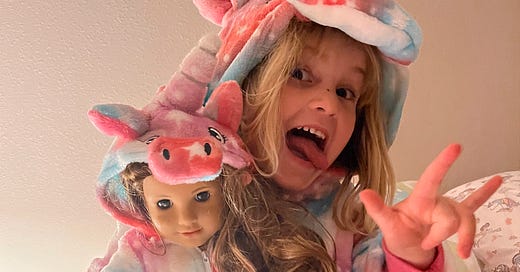When I was a child, for birthdays and Christmas my grandma always bought my sister and I collectible porcelain dolls. Our favorites lined the shelves high up in our rooms, but many stayed perfectly styled with hairnets and tissue paper in boxes in a closet.
The dolls were pristine, waiting for some someday when I suppose we were supposed to know what to do with all these collectible dolls. The dolls were something my grandma loved and she was loving us by sharing her favorite things with us.
Looking back I wonder—Was this some kind of investment? Am I supposed to display these dolls in my home as an adult? Am I supposed to sell them? The intentions, other than sharing something that brought her joy, are unclear—but what was clear—these dolls were not meant to be played with.1
There was one kind of doll I always longed for as a girl. I had the books and the catalogs would regularly appear. I’d circle the pages and reread the stories, but I never had one of my own in my possession. American Girl dolls. The coveted gift of every 90s girl—the original historical dolls were always just out of reach.
For Christmas last year, we bought our 4-year-old an American Girl doll. We choked at the price tag, but the 90s kid in me knew a Target dupe wouldn’t do. It had to be American Girl. Maeve adores Lila (the 2024 American Girl of the Year), but surely Maeve does not properly care for her overpriced doll. She doesn’t realize how much more expensive Lila was compared to her other baby dolls. Her hair is messed up and often she is undressed, but Maeve absolutely knows that Lila is special. Lila goes everywhere with Maeve. They snuggle every night in matching pajamas with their matching hazel eyes. Lila is a doll that could be placed on a shelf, but for what purpose? She gets her outfits changed and is dragged around the house and stuffed into toy cribs. Her value is magnified every time she brings joy to her human American girl through play.
I’ve heard a lot recently about using your stuff. People often like to do a “no buy” or “low buy” January, and focus instead of using the things they already have. Using up makeup products and pantry staples is admirable for those who naturally buy something before they run out. I think my default is low buy/under buying. I’d rather make do with what I have, rather than have something around that I won’t actually need.
A couple years into our marriage, Adam made breakfast and served it on our wedding china. I was so confused—why are we using our wedding china? Isn’t it supposed to stay in a box and stay perfect forever? Then he reminded me that we picked out dishwasher safe china in order to actually use it. Have some pieces been lost or broken?—certainly. But we get—not only joy from seeing something from our first days married—but functionality from those pieces now. They serve a purpose and they serve us by being in our home. Just like Maeve's American Girl doll, which, though theoretically more valuable as a pristine collectible, becomes priceless through her play.
I think about decluttering a lot. I tend toward maximalism generally—but I also want my space to be organized. I want to know where my things are. I want to know where to find a particular item when I think about it.
On the other hand, I also have an impeccable memory. I remember the story behind every item. And I’m also pretty sentimental. I remember when my son wore that Mandalorian costume every day for months on end. I remember when the kids couldn’t get enough of that rocket ship toy, but now they’ve gone months without touching it. I remember when my daughter made me read her that Hungry Little Caterpillar book until we both had it memorized.
I am trying to reconcile keeping only what we actually need and want, and also archiving memories that are important to me now and will certainly be even more important to me later. It's about recognizing that the value of these things isn't just in their physical presence, but in the stories they hold, stories that live on even if the object is gone.
From the untouched collectibles of my childhood to the well-loved toys of my daughter’s, value is more than monetary. Things aren't static— the meaning they hold shifts depending on how we interact with them. A doll on a shelf represents potential, but a doll cradled in a child's arms—hair a tangled mess—embodies love, imagination, and the messy reality of life—something far more precious than anything bought or sold. It’s a value that grows—with every shared meal on wedding china, every imaginary tea party with a beloved doll, every story time snuggled up with a favorite book. It’s a value that reminds me: the greatest treasures are the ones we use, the ones we love, and the ones that will always be part of our lives.
After publishing this, my sister reminded me that my Grandma was a child of the depression. She didn’t have dolls, let alone nice porcelain dolls. This makes a lot of sense in explaining the abundance she was giving her grandchildren that she didn’t have access to.




